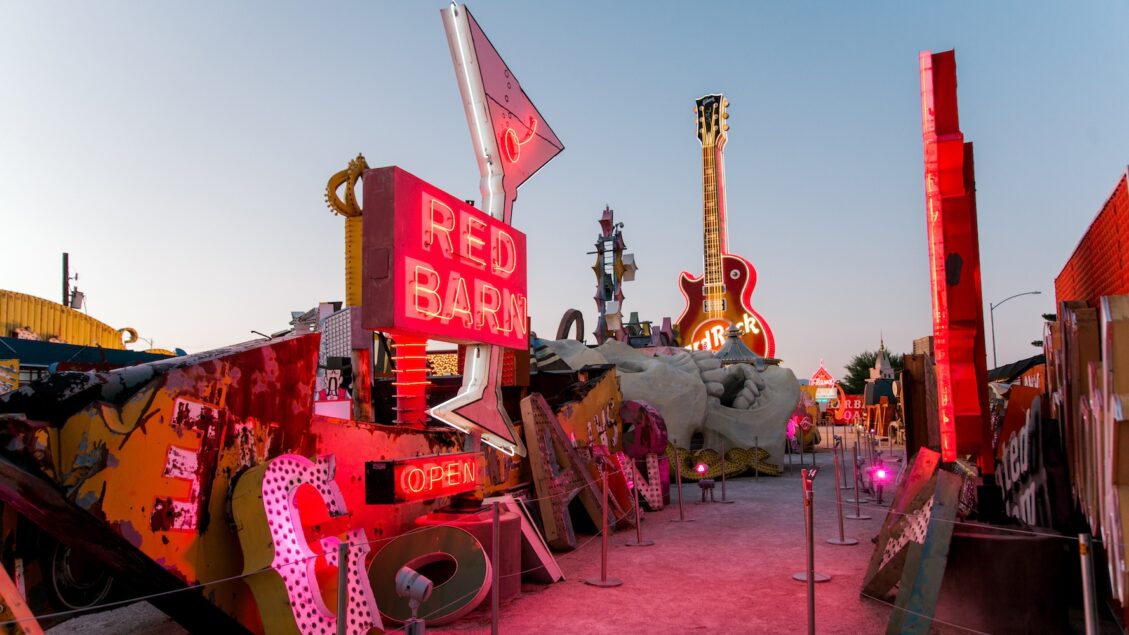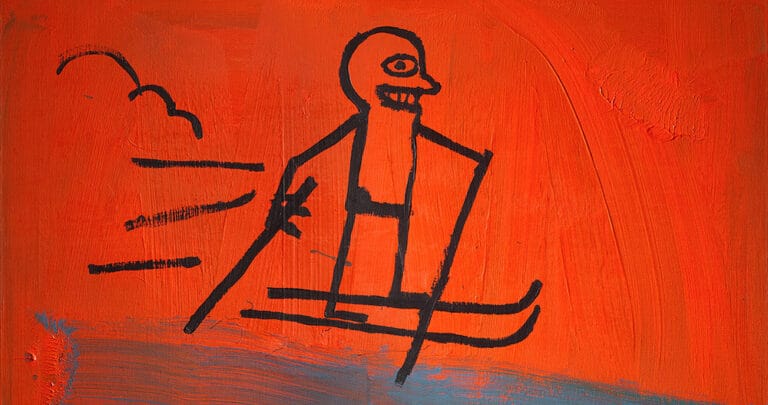What Happens in Vegas: Three Days at Duck Duck Shed
✕
There are a few ways a writer for an architecture magazine can approach going to Las Vegas. One is the Learning from Las Vegas way, the dispassionate mode of travel-as-study made famous by Denise Scott Brown and Robert Venturi, whose 1968 Yale studio measured parking lots, diagrammed neon signs, mapped the strip, and then promptly returned to New Haven to report its findings. This is still more or less the usual architectural way of going to Vegas. Then there is the degenerate way, the embrace of sin exemplified by Hunter S. Thompson’s Fear and Loathing in Las Vegas (1971), in which a magazine assignment becomes an opportunity to acquire a serious narcotics collection and then embark on an absolutely disgusting city-spanning bender that more than earns the book’s subtitle: A Savage Journey to the Heart of the American Dream.
Architectural Record is not a publication that tolerates degeneracy, so I stayed away from drugs over the course of my three-day stay in Vegas. In any case, I was there to cover the third edition of Duck Duck Shed, an annual conference of sorts organized by the Neon Museum that takes its inspiration and name from Scott Brown and Venturi, specifically from the distinction they introduce between “ducks” (buildings whose very form communicates symbolically) and “decorated sheds” (generic buildings adorned with communicative elements) in regard to the Las Vegas Strip. Thankfully, the organizers saw to it that there was nonetheless fun to be had. I witnessed an elaborate talk by Steve Crupi, the Implosion Guy, a former TV reporter who, true to the promise of his moniker, is so enamored of his subject matter that he has dedicated a second career to presenting footage of the “most magnificent” implosions in Vegas history, some replete with fireworks and plumes of burning jet fuel, set to melodramatic orchestral music and played in epic slow motion. (When an audience member asked if he’d like to see any still-existing buildings imploded, Steve unhesitatingly replied, “the Trump hotel,” to resounding applause.) I attended a movie premiere held at a swim club on the roof of a casino, where—contrary to expectations—I had a great time drinking palomas and watching the wildly entertaining, decidedly B-list Action! Action! as friends of the cast erupted into periodic cheers. And, yes, I listened to a talk on Learning from Las Vegas, but in true Vegas style it was given by the criminal defense lawyer turned true-crime-commentator Dayvid Figler, and was considerably more enjoyable than most architecture events I attend.

The Neon Museum. Photo © Yaxuan Liu
I had some very good food, and met some very interesting people. Duck Duck Shed is not a big or famous event, but it has a loyal following—particularly, it seemed to me, among locals interested in their city’s history and architecture (the verdict from one couple: “the best year yet”). In spite of its name, Duck Duck Shed succeeds because it resists descending into the usual architecture-in-Las-Vegas disagreements about the relevance or lack thereof of good taste, or whether it is acceptable to construct a faux Eiffel Tower in the Nevada desert. Instead it offers space to learn and think about the city in all its complexity. Aaron Berger, the Neon Museum’s disarmingly down-to-earth director—throughout the conference, he could be found running around the room offering a mic to audience members with questions—describes his goal as offering “intellectual meat on the bone” in a city where rarefied museum culture is decidedly alien. And this doesn’t mean being boring; it means figuring out ways for the museum to meet its audiences on their own turf while sneaking in some valuable lessons along the way. One such effort is a new self-guided architecture and design tour of the museum’s collection of neon signs, put together by curator Mariana Gonzalez. Another is Duck Duck Shed.
I learned that casino carpeting is woven in sheets up to 36 feet wide, and must consist of 80 percent real wool to prevent cigarette burns. I learned that stadium seating can reach a maximum, vertigo-inducing pitch of 36 degrees. I learned that it costs an eye-popping $120—not including the mandatory fee of $12 for storing a bag—to visit the Sphere, and I can now attest that it is just as enormous and immersive as advertised. I made my way on foot up the Strip, crisscrossing Las Vegas Boulevard on pedestrian bridges filled with boisterous crowds of tourists, moving from the Bellagio through Caesars to the Venetian to the Wynn, only then finding myself deposited outside by a service road where I caught a glimpse of Paul Revere Williams’s polychrome Guardian Angel Cathedral—built in 1955 to provide space for Catholic hospitality workers to worship. According to Figler, it is one of only five buildings on the Strip that have remained largely untouched since the 1960s.

1

2
Scenes from Duck Duck Shed’s 2025 gathering, including talks by Dayvid Figler (1) and Steve Crupi (2). Photos © Neon Museum
Much less interesting was the Fontainebleau Las Vegas, the $3.7 billion, 3,500-room monolith that is the newest resort on the Strip, and which, as I learned at a presentation given by four of its designers, pays homage to Morris Lapidus, architect of the Fontainebleau Miami. I don’t think I fully understood why most Vegas casino floors are labyrinthine spaces of discovery rendered in warm fabrics until I visited the sterile, convention-center-like Fontainebleau, which makes you feel small and all too exposed under its bright LED lighting, snapping you out of any seductive fantasies that the rest of the city may have conjured.
On a tip from Rick Hooker, a former cultural officer for the famed former mayor Oscar Goodman, who led Duck Duck Shed’s downtown walking tour, I visited the men’s room at the Main Street Station casino, where a large chunk of the Berlin Wall is ensconced directly behind a row of urinals. For some reason, this felt like my cue to try out gambling for the first time, which resulted in an immediate loss of $40 (plus ATM fee) and the discovery that modern slot machines are not nearly as straightforward as the ones you see in movies. I had more fun afterward, wandering in and out of the crowded souvenir shops and past the street vendors that line the Fremont Street Experience, the enormous barrel-vaulted LED screen that transforms the core of downtown into an enormous party replete with zip-liners zooming by overhead and musical performers of varying levels of talent. Under this soaring roof, as in many places along the Strip, you encounter an extraordinary variety of people—from Las Vegas, from around the country and world—who are mostly if not universally having a good time, and mostly if not universally finding ways to get along as their existences overlap in a momentary blur of money, alcohol, music, and neon.

The Fremont East district in downtown Las Vegas. Photo © Yaxuan Liu
Far too much has been written about Las Vegas’s artificiality, as if the veneer of artifice makes this place any less real for those who live in or choose to visit it. There is nothing unreal about the “cosmopolitan canopy” of Fremont Street, to adopt an apt term coined by the sociologist Elijah Anderson, or about any of the multitude of characters—historical or very much alive—that I encountered over the course of my three days at Duck Duck Shed. Indeed, Las Vegas as a whole is a city premised on the chaos and possibility of people coming and going, of free movement—one where over 150,000 hotel rooms play host to tens of millions of visitors from around the globe every year, and where, in recent decades, hundreds of thousands of people—mostly from Latin America—have moved in search of stability and opportunity. For all of its long-standing inequities, its haphazard planning, its environmental spoilage—for all of its sins—Las Vegas presents a profoundly welcoming vision of what a place can be. And this vision is worth fighting for at a moment when it is increasingly under threat. Thousands of undocumented workers and their families now live in fear of impending immigration raids. Visitor numbers have fallen as foreign citizens think twice about entering the United States. Nevada’s unemployment rate is the highest in the country, and, according to Berger, attendance at the Neon Museum has fallen 10 percent since January 20.
I left Las Vegas with the image of the city as miniature world: half asleep in the backseat of a 5 a.m. Uber to the airport, I opened my eyes and saw, outlined against the jagged profile of distant mountains, oversize palazzos and Roman temples, the great Luxor pyramid, the Empire State Building and Eiffel Tower, the glimmering orange slab of Mandalay Bay rising over lush blue-green pools, tens of thousands of darkened windows reflecting back the peaceful glow of an enormous digital moon—the Sphere, not yet awakened, awaiting the impending sunrise.







